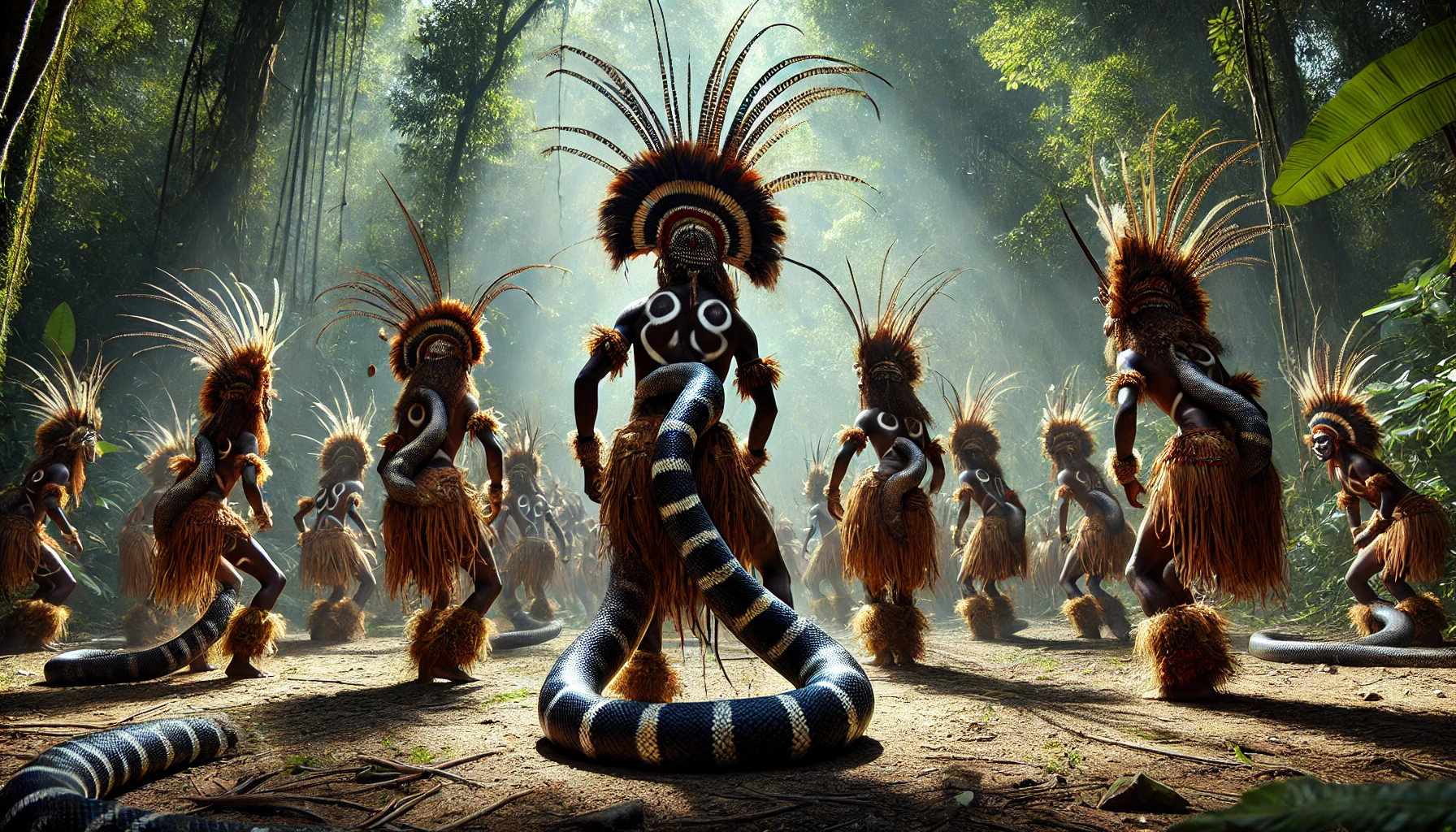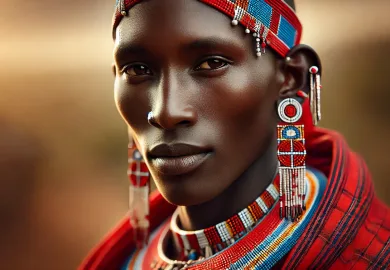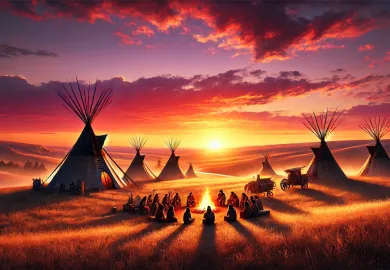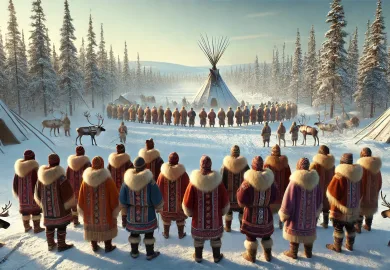
Papua New Guinea is a land of immense cultural diversity, where ancient traditions and rituals remain central to the identity of its many indigenous communities. Among these, the Black Snake Dance performed by the Apenda Clan stands out as one of the most mysterious and deeply revered ceremonies. This article delves into the origins, significance, and intricate details of this captivating ritual, providing an in-depth look at a tradition that has endured for generations in the remote highlands of Papua New Guinea.
The Origins of the Black Snake Dance: A Journey Through Time
The origins of the Black Snake Dance are shrouded in the mists of time, with oral histories passed down through generations of the Apenda Clan. This dance is believed to have been initiated by the clan’s ancestors as a way to connect with the spiritual realm and to honor the powerful spirits of the natural world, particularly the snake, which is revered as a symbol of life, death, and rebirth.
According to clan elders, the dance was first performed centuries ago, during a time of great strife and upheaval. It is said that a massive black snake appeared to the clan’s forebears in a dream, guiding them to perform this sacred dance to restore balance and harmony to their world. This serpent, regarded as a powerful totemic being, is believed to embody the life force of the clan and the surrounding environment. The dance, therefore, serves as a vital link between the people, their ancestors, and the natural world.
The Apenda Clan’s reverence for the snake is deeply rooted in their cosmology, where it is seen as a guardian and protector. The Black Snake Dance is not merely a ritual but a profound expression of the clan’s spiritual beliefs, encapsulating their respect for the cycles of nature and the interconnectedness of all living things.
The Ritual Preparations: A Sacred Gathering of the Clan
Before the Black Snake Dance can be performed, extensive preparations are required, involving the entire Apenda Clan. The ritual is held annually, often coinciding with the harvest season, which is a time of both celebration and gratitude. The preparations begin weeks in advance, as the clan members gather materials, prepare costumes, and rehearse the dance under the guidance of the elders.
Central to the preparations is the creation of the ceremonial attire, which is of great importance in the Black Snake Dance. The dancers wear elaborate headdresses adorned with feathers, shells, and other natural materials that symbolize the connection to the earth and the spirits. Their bodies are painted with intricate designs, using pigments made from plants, clay, and charcoal. These designs are not merely decorative but hold deep symbolic meanings, representing the snake’s patterns and the clan’s lineage.
The musical instruments used in the dance are also carefully prepared. Traditional drums, made from hollowed-out logs and covered with animal skins, provide the rhythmic foundation for the dance. Bamboo flutes and other wind instruments add to the haunting melodies that accompany the ritual, creating an atmosphere that is both mesmerizing and otherworldly. The music, combined with the dancers’ movements, is believed to invoke the presence of the ancestral spirits, inviting them to partake in the ceremony.
The Dance Itself: Movements of Mystery and Reverence
The Black Snake Dance is a powerful and evocative performance that combines fluid movements, rhythmic music, and a deep sense of spiritual connection. The dance begins at dusk, as the sun sets and the night envelops the village. The darkness is symbolic, representing the mysteries of the spirit world, and the dancers’ movements mirror the sinuous, undulating motions of a snake.
As the dance progresses, the rhythm of the drums intensifies, and the dancers move in unison, weaving and circling around a central fire. The fire represents both the warmth of life and the destructive power of nature, embodying the duality that is central to the clan’s beliefs. The dancers’ movements are slow and deliberate, each step resonating with meaning and purpose. The snake is not just a creature in this dance but a living symbol of the cycle of life and death, fertility, and transformation.
The climax of the dance is reached when the lead dancer, often the most respected elder of the clan, performs the “serpent’s embrace,” a gesture that symbolizes the unity of the clan with the snake spirit. This moment is charged with emotion, as the onlookers, who have remained silent and reverent throughout the performance, erupt in chants and songs of praise. The energy of the dance, combined with the rhythmic beating of the drums, creates a trance-like state, both for the dancers and the audience.
The Black Snake Dance is not just a performance but a living tradition that reinforces the Apenda Clan’s connection to their heritage. It is a celebration of life, an acknowledgment of the inevitable cycles of nature, and a reminder of the clan’s place within the greater cosmos.
The Significance of the Black Snake Dance: A Symbol of Unity and Continuity
The Black Snake Dance holds immense significance for the Apenda Clan, both as a spiritual ritual and as a social event. It serves as a unifying force, bringing together all members of the clan, from the youngest children to the oldest elders. In a society where communal bonds are essential for survival, the dance reinforces these connections, reminding everyone of their shared heritage and responsibilities.
One of the most important aspects of the Black Snake Dance is its role in the transmission of cultural knowledge. The dance is an oral tradition, with each generation learning the steps, songs, and stories from their elders. This ensures that the clan’s history, beliefs, and values are passed down, preserving their identity in a rapidly changing world. The dance is a living archive, a way of teaching the young about the past while preparing them for the future.
Furthermore, the Black Snake Dance is a powerful expression of the Apenda Clan’s relationship with the natural world. The snake, as a totemic figure, embodies the clan’s understanding of the environment and their place within it. The dance is a form of communication with the spirits of the land, asking for their protection and blessings. It is also a way of giving thanks for the bounty of the earth, particularly during the harvest season when the dance is often performed.
In a broader context, the Black Snake Dance can be seen as a symbol of resilience and continuity. Despite the challenges posed by modernization and external influences, the Apenda Clan has maintained this tradition, adapting it to contemporary circumstances while staying true to its core meanings. The dance is a testament to the strength of cultural identity and the importance of preserving indigenous knowledge for future generations.
Conclusion: The Black Snake Dance as a Timeless Tradition
The Black Snake Dance of the Apenda Clan is more than just a ritual; it is a profound expression of the clan’s spirituality, culture, and identity. Through its elaborate preparations, symbolic movements, and deep significance, the dance encapsulates the essence of the Apenda people and their connection to the world around them.
As we witness the enduring power of the Black Snake Dance, we are reminded of the importance of preserving such traditions in a world that is increasingly disconnected from its roots. The dance is a living link to the past, a celebration of the present, and a beacon for the future. It is a reminder that, in the face of change, some things remain timeless, offering a sense of continuity and belonging in a rapidly evolving world.
The Apenda Clan’s commitment to the Black Snake Dance is a powerful example of how cultural heritage can be both a source of strength and a means of navigating the complexities of the modern world. As long as the dance continues, the spirit of the Apenda people will endure, carried forward by the rhythms of the drums, the movements of the dancers, and the whispers of the ancestors.








